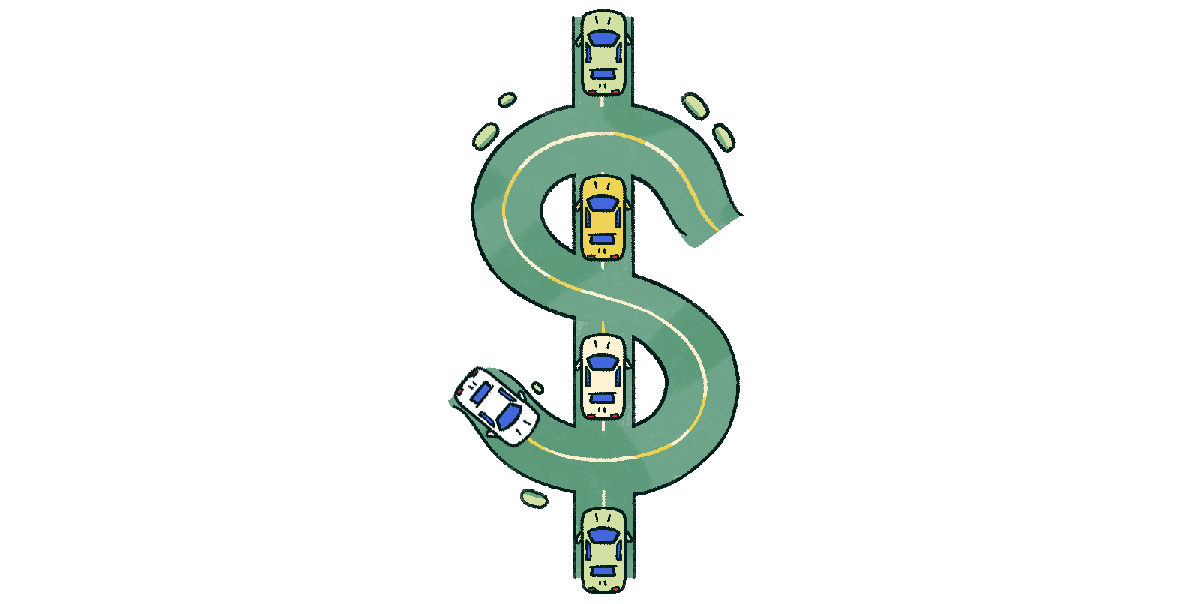This article is part of the Ask Umbra 2021 Holiday Makeover.
The greenest way to travel is not to travel, of course. But not even a life-threatening global pandemic can keep people from crisscrossing the country to see their loved ones for the holidays. An optimist might say there’s something powerful in that kind of devotion to the people we care about. Yes, our travel causes greenhouse gas emissions, but should it be wholly shamed for that?
So in the interest of reducing our travel-induced guilt, let’s talk about next-best and next-next-best options. Which route is most climate-friendly to drive? Should I rent an EV just for a weekend jaunt? What’s the most carbon-efficient option between buses and trains?
To help unmuddle the picture, we’ve put together some helpful information you can use to make your own climate-friendly travel decisions.
“The plane is going to fly anyway — does it really matter if I’m on it or not?”
 According to Mike Childs, head of science, policy, and research for Friends of the Earth U.K., it does matter whether you’re on the plane. The more flights you get on, the more it encourages airlines to put more planes into the air — and more planes means more emissions. Ideally, Childs said, travelers should selectively choose a small number of flights — maybe one round trip a year — and ensure that the planes they’re getting on are at full capacity, since a fuller plane is a more efficient one. One possible way to do this is to opt for flights on budget airlines, which may be less willing to eat the costs of chartering a plane at only half-capacity. But overall, Childs said, “we’ve got to get used to thinking that we shouldn’t fly as frequently.”
According to Mike Childs, head of science, policy, and research for Friends of the Earth U.K., it does matter whether you’re on the plane. The more flights you get on, the more it encourages airlines to put more planes into the air — and more planes means more emissions. Ideally, Childs said, travelers should selectively choose a small number of flights — maybe one round trip a year — and ensure that the planes they’re getting on are at full capacity, since a fuller plane is a more efficient one. One possible way to do this is to opt for flights on budget airlines, which may be less willing to eat the costs of chartering a plane at only half-capacity. But overall, Childs said, “we’ve got to get used to thinking that we shouldn’t fly as frequently.”
However, Gregory Miller, executive director at the Center for Responsible Travel, a nonprofit that advocates for culturally and environmentally conscious travel, emphasized that climate is simply not the major priority for most people when flying, particularly around the holidays. “I would never say to someone that you should not go home because you’re worried about your emissions footprint,” he said; connections with close friends and family make life worth living.
Rather than submit to the inevitability that airlines will continue to schedule flights whether you like it or not, Miller said that travelers should feel empowered to choose flights that are at least a little less bad for the environment. He suggested following the NERD criteria: Whenever possible, take flights on newer aircraft, sit in an economy seat, pick a regular-sized airplane (jumbo jets tend to guzzle up more fuel per passenger), and opt for direct flights rather than those with multiple layovers.
So what’s the right thing to do? It more or less comes down to where you’re starting from. Both Miller and Childs suggested that travelers think about the frequency of their flights — if you’re a flight-a-month frequent traveler, then it’s probably time to think about scaling back your air travel. If you’re a once-a-year traveler who only uses planes to return home to family? Well, you’re still a little complicit in the flight problem, but you’re not part of the relatively small minority that’s driving it.
“Is it really worth paying to offset my cross-country flight?”
Most major airlines now offer passengers the opportunity to cancel out their flights’ emissions by purchasing carbon offsets. Certain websites allow you to estimate the amount of CO2 you are personally responsible for emitting into the atmosphere. If you’re taking a 2,500-mile flight from Seattle to Boston, for example, then you’ve produced 0.5 metric tons of CO2, and you can offset it for just five bucks.
Considering that you’ve probably already paid a few hundred dollars for your flight, it’s not a lot to cough up. But what exactly does that additional $5 accomplish?
Offset payments can go toward a number of projects to reduce carbon emissions. Perhaps the easiest to understand is tree planting. Under this kind of program, your offset money goes toward the planting of a number of trees that, theoretically, will sequester in their trunks as much CO2 as was emitted by your plane trip. Other offset schemes might involve capturing greenhouse gas emissions from landfills or paying a rice farmer to use practices that reduce the methane emissions from their rice paddies.
On paper, it all works out nicely: Carbon emitted equals carbon sequestered. Perfect in theory — but in practice, it’s not so neat. Independent analyses of carbon offset projects have often revealed them to be ineffective and unreliable. In 2019, reporter Lisa Song wrote for ProPublica that “[i]f the world were graded on the historic reliability of carbon offsets, the result would be a solid F.”
So should you offset your flight? Maybe. But look for an offset program that’s verified by a reputable third party, like The Gold Standard, and be aware of many caveats. Mike Childs, with Friends of the Earth U.K., said that buying offsets can lull travelers into a false sense of security — offsetting their guilt but not their carbon footprint. “You’re still contributing to pollution,” he said. It would be more effective, from an emissions standpoint, to simply take one fewer flight each year — especially if you’re a frequent flyer or wealthy traveler.
“Should I take the longer route with less traffic, or the shorter route with more traffic?”
 It depends. If you have an older, gas-guzzling car, then it’s probably best to avoid traffic at all costs. All that stopping and starting and idling can end up making your drive not only very frustrating, but also pretty inefficient. One 2013 study from Carnegie Mellon University found that greenhouse gas emissions from gasoline-powered cars tripled on heavily congested New York City streets as compared with conditions on the highway.
It depends. If you have an older, gas-guzzling car, then it’s probably best to avoid traffic at all costs. All that stopping and starting and idling can end up making your drive not only very frustrating, but also pretty inefficient. One 2013 study from Carnegie Mellon University found that greenhouse gas emissions from gasoline-powered cars tripled on heavily congested New York City streets as compared with conditions on the highway.
But according to Jeremy Michalek, a Carnegie Mellon professor of engineering and public policy, there’s less of a difference if you’re driving a hybrid or an electric vehicle. Electric technology prevents cars from wasting energy at intersections or in severe stop-and-go traffic, taking the idling consideration more or less out of the question. And regenerative braking technology allows hybrid and electric cars to convert their motion into electrical energy, which can be stored in their batteries.* So frequent stops might not be so big a deal if you’re driving one of these newer, more efficient rides. The bottom line, he said, is that an electric or hybrid vehicle can do pretty well, emissions-wise, in the city or on the highway.
Regardless of the kind of car you drive and which route you take with it, Michalek has some rules of thumb. “Drive more gently,” he said. “The more you accelerate really quickly and then come to a quick stop — that type of aggressive driving certainly consumes more energy,” resulting in more carbon emissions per mile. Michalek also suggested driving slowly — for gas-powered cars, the Department of Energy says that speeds above 50 miles per hour can rapidly eat away at your fuel efficiency. The calculus is a little different for EVs, but going faster still means your car has to overcome more drag, thereby putting a greater strain on the vehicle’s battery.
Finally, Michalek suggested that whatever route you take, try to avoid traffic by planning ahead. You can easily use apps like Waze to take your journey at the least busy time of day, potentially avoiding this conundrum in the first place.
“If I have to rent a car, does it make a difference if I get an EV or a combustion-engine car?”
It seems like a no-brainer, but let’s state the obvious: An electric vehicle will emit fewer emissions than its combustion engine counterparts — even if it’s charged in a fossil fuel-powered grid. “In terms of the amount of carbon you’re going to burn, the electric vehicle will be better” than a gas-powered car, said Genevieve Giuliano, director of the METRANS Transportation Center at the University of Southern California.
But you’re just one little driver on the wide-open road, so what difference does that make? Well, if customers increasingly seek out EVs from their rental car companies, it can encourage those companies to invest more heavily in an electrified fleet. In the U.S., only one rental car company, Hertz, has made big commitments in that regard. In October, the company announced that it had ordered 100,000 electric vehicles from Tesla — the biggest EV purchase ever. Tim Johnson, an energy and environment professor at Duke University, says that if Hertz’s program proves to be popular with customers, it could encourage other rental companies to jump into the EV game.
“But where will I charge the car?!” you might ask. Surveys have consistently found a lack of charging infrastructure to be the most significant barrier preventing people from purchasing an EV. According to the Department of Energy, there are currently around 43,000 public EV stations in the U.S., compared to more than 150,000 gas stations. Plus, these charging stations aren’t evenly distributed. Unless you live in a populous, renewable energy-loving state like California, Massachusetts, or Colorado, your odds of easily finding places to charge up may not be so good.
Charging is expected to become less of a burden as the Biden administration chips away at its plan to install 500,000 new charging stations nationwide. For now, however, Giuliano said the bottom line is that you should rent the EV but research places to charge along the route and at your destination in advance — and perhaps build some extra charging time into your travel plans.
“Should I opt for the long-distance bus or train?”
The American Bus Association would happily answer this question — according to their 2019 comparison of different transportation modes, long-distance buses take the cake as by far the most CO2-efficient option out there. Their carbon footprint per mile per passenger is a quarter of Amtrak’s.
There’s obviously a risk of bias in that study, but other reports from the Union of Concerned Scientists, Farmingdale State College, and National Geographic support its findings.
According to Kara Kockelman, a professor of transportation engineering at the University of Texas at Austin, trains might underperform buses because of their stations’ high energy consumption, or the fact that in low population density areas they often run below capacity. Other experts blame the diesel fuel that many trains run on — especially in the U.S. — as well as the high energy inputs associated with maintaining a functional railroad line.
But Kockelman and others also stress the importance of relativity. “The topline message is that public transit is in almost all cases going to be better than driving your own car,” said Elizabeth Irvin, a senior transportation analyst for the Union of Concerned Scientists. (She includes any kind of mass transportation, including Amtrak and privately owned bus lines, in “public transit.”) There are some exceptions depending on the distance traveled, whether you have a hybrid or electric car, and the number of travelers you’re going with, but in general, long-haul buses and trains are going to be a climate win.
Tierra Bills, an assistant professor of civil and environmental engineering at Wayne State University, added that there is room for improvement for both buses and trains. “Sexy” transportation options like high-speed electrified rail could dramatically reduce the need to drive or fly between population hubs like Los Angeles and San Francisco. But other places may be better served by investments in rapid, electrified bus services, which are more likely to reach rural areas. She also stressed the need to consider equity impacts of transportation investments. “Where we are now,” she said, “improvements are more likely to benefit more affluent communities than marginalized and disadvantaged communities” — due in part to housing policies that push less wealthy people away from transportation hubs.
Christopher Cherry, a professor of civil and environmental engineering at the University of Tennessee, agreed, stressing the need to craft a transportation system that reaches all people. In his “dream scenario,” buses and trains work together to seamlessly connect everyone to the places they’re trying to go.
“Does any of this actually matter? I thought personal responsibility for climate change was a hoax created by fossil fuel companies.”
 Fossil fuel interests have long tried to offload responsibility for the climate crisis onto individual consumers, along the lines of: You’re the ones burning the oil and gas in your car engines, in your homes, on your stoves. BP popularized the term “carbon footprint” in the early 2000s, even as it made plans to explore for more oil and gas reserves.
Fossil fuel interests have long tried to offload responsibility for the climate crisis onto individual consumers, along the lines of: You’re the ones burning the oil and gas in your car engines, in your homes, on your stoves. BP popularized the term “carbon footprint” in the early 2000s, even as it made plans to explore for more oil and gas reserves.
Even still, it’s a question worth grappling with — especially when it comes to very carbon-intensive activities like flying.
“There’s no way you can say that an individual’s emissions are morally negligible,” said John Nolt, a professor emeritus of philosophy at the University of Tennessee. In 2011, he did some “back-of-the-envelope” calculations that led him to conclude that the average American’s lifetime greenhouse gas emissions caused “the serious suffering and/or deaths of two future people.” Another, more recent and more rigorous calculation found that 3.5 average Americans’ lifetime emissions will cause one excess death this century.
Kind of puts a damper on holiday travel plans, doesn’t it? But to Nolt, the idea isn’t to obsess over every gram of CO2, which can lead to emotional paralysis or depression. He suggests a “sense of proportionality” that recognizes the moral significance of our actions, while also taking care of ourselves and others. For example, there are scenarios in which our moral responsibilities to friends and family may override our responsibility to cut carbon emissions.
“Things that will contribute to your life and the lives of people that you love that cost some carbon? That can be justified,” Nolt said. “If you’re just going out and riding around in large vehicles because you don’t care, that’s very different.”
Jay Ting Walker, a Pittsburgh transit advocate and vice chair of the Allegheny County Green Party, emphasized the importance of political engagement. Focusing too much on individual carbon emissions can lead to burnout, he said, distracting people from the systemic changes that are needed to build a greener, more equitable transportation system — one that is low-carbon and convenient, and doesn’t feel like a sacrifice. “We need collective action to make the changes we need,” he said.
*Correction: This story previously misstated the way that regenerative braking technology converts motion into electrical energy.



